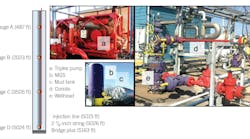A stratigraphic test operated by BP Exploration (Alaska) Inc. at Prudhoe Bay has confirmed two gas hydrate reservoirs for further testing in a three-well joint program of the US Geological Survey, US Department of Energy’s National Energy Technology Laboratory, and Japan Oil, Gas, and Metals National Corp.
USGS said the test confirmed “highly saturated gas hydrate-bearing reservoirs” designated Unit B and Unit D.
Drilling by the Parker 272 rig encountered Unit B at 2,770 ft below surface. The hydrate was interpreted to fill 65% to more than 85% of porosity in the upper 40 ft of the unit, composed of well-sorted, very fine-grained sand to coarse silts.
Unit D, occurring at about 2,300 ft, has similar saturation ranges. The shallower unit also has a water-bearing section at its base.
Cores were cut in the units and maintained at reservoir pressure and temperature for analysis in the US and Japan.
USGS said the three-well program is designed to test response of the gas-hydrate reservoirs to controlled depressurization.
It’s part of a 35-year cooperative research program evaluating potential of gas hydrate in Alaska. In 2008, USGS estimated the technically recoverable gas hydrate resource on the Alaskan North Slope at 85 tcf of natural gas.
USGS also has participated in drilling to investigate gas hydrate potential offshore India and in the Gulf of Mexico and is conducting other research.
